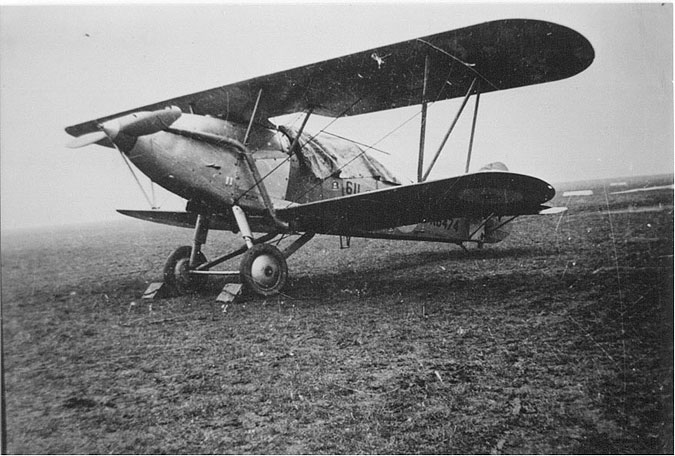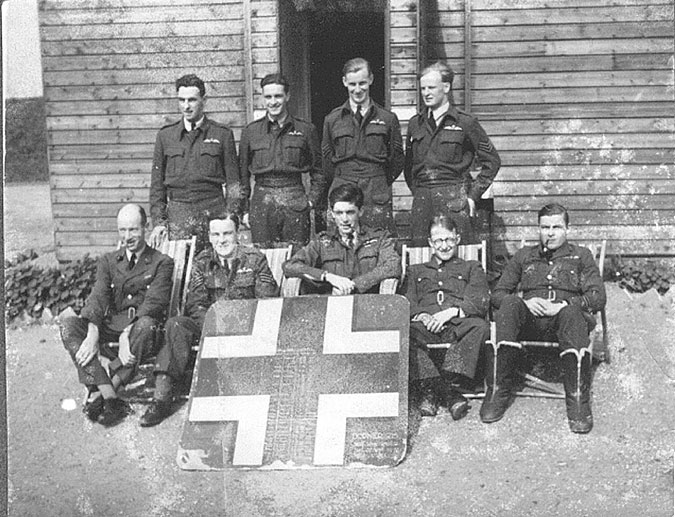Auxiliary squadrons were first envisaged during World War One by Sir Hugh Trenchard and were set out in a document prepared by him in 1919. A Bill was drafted in 1922 but did not become law until 1924. Provision was made for six Auxiliary squadrons and seven Special Reserve squadrons with 502 (County of Ulster) becoming the first to form in 1925. 502 was joined by 602 (City of Glasgow) Squadron in September 1925, followed in the same year by 600 (City of London), 601 (County of London) and 603 (City of Edinburgh) Squadrons with 605 (County of Warwick) forming on 5 October 1926, followed by 604 (County of Middlesex) in March 1930 with 607 (County of Durham) and 608 (North Riding) forming in the same year. There was a gap of six years before 609 ((West Riding of Yorkshire) formed on 10 February 1936, with 610 (County of Chester) and 611 (West Lancashire) following in the same month. Ten more Auxiliary squadrons were to follow.
611 West Lancs (Bomber) Squadron was formed in name only on l0 February 1936 at RAF Hendon, London, five days after the Liverpool City Council had granted a tenancy to the Air Ministry of five acres of land to the East of the Chapel House Farm, Speke, on which the tenant was to construct roadways and erect temporary buildings. The Squadron formed as a unit of the Auxiliary Air Force, a reserve organisation similar to the Territorial Army and Flt Lt H C Parker was posted in as Adjutant. AAF squadrons had a small nucleus of regular personnel who were mainly concerned with administration and aircraft maintenance, but the majority of the officers and men were recruited from geographical areas local to the unit and trained at weekends and during the two-week annual training camp. Hence 611 was irrevocably linked to Liverpool and West Lancashire.
The squadron never received aircraft at Hendon but moved to Liverpool and then to Speke airport from 1 may 1936 when they took over newly built Squadron accommodation on the west side of the airfield.
 The intended role of the new Squadron was Day Bomber, using single-engined Hawker Hart biplanes, and this role was maintained until l January 1939, when the Squadron was re-classified as a Fighter unit.
The intended role of the new Squadron was Day Bomber, using single-engined Hawker Hart biplanes, and this role was maintained until l January 1939, when the Squadron was re-classified as a Fighter unit.
On 18 and l9 May the first three Avro Tutor training aircraft arrived, (K3383, K3429 and K3424) followed on 4th June by the first Hawker Hart Trainer (K6474) on 4 June, followed by two more on 10 June (K3044 and K3878). The first squadron flight took place in May 1936 and total flying time for the month amounted to one hour!
Initial equipment was the Hawker Hart single engined bi-plane light bomber with crew training utilising the Avro Tutors. In 1938 the Harts were replaced by the more powerful Hinds. On reclassification as a fighter squadron the Hinds were retained until 19 May 1939 when they received their first six Spitfire I's at Speke.
611 was at Duxford, Cambs, for their summer camp when war was declared and they were embodied into the Air Force and retrained at Duxford as their war station. Dispersed in case of sudden enemy air attack they lived in tents on the sough west corner of the airfield. The CO since conception was Sqn Ldr G L Pilkington of the famous St Helens glass manufacturing company of the same name. Pilkington had other war duties and Flt Lt J E McCombe took over as Co at Duxford, shortly to be promoted to Sqn Ldr. Initially the Squadron trained hard with their new fighters and were required to send flights forward to Watton, North Coates and other airfields for daytime readiness. Having just moved form the tents into the warm brick barrack blocks they were instructed to move to Digby, Lincs on 10 October.
 The first encounter with the Luftwaffe took place on 21 October 1939 when Sgt Mather joined two Spitfires from 72 Sqn and attacked ten enemy aircraft with uncertain results but a possible was claimed. HM The King visited Digby and inspected the squadron on 2 November 1939. Things started to settle into a routine of training, alerts and readiness interrupted by a very cold winter with snow often stopping all flying.
The first encounter with the Luftwaffe took place on 21 October 1939 when Sgt Mather joined two Spitfires from 72 Sqn and attacked ten enemy aircraft with uncertain results but a possible was claimed. HM The King visited Digby and inspected the squadron on 2 November 1939. Things started to settle into a routine of training, alerts and readiness interrupted by a very cold winter with snow often stopping all flying.
The first of many pilot losses occurred on 28 February 1940 when Sgt A E A Bruce failed to return but not from enemy action. The original Spitfires were replaced by newer ones but still Mk I's in the beginning of an amazing number of aircraft changes that was to continue until the end of the War. The Squadron utilised over 400 Spitfires from September 1939 to March 1945 but never had more than 25 on strength at any one time and normally only 20.
611 was overhead the Dunkirk beaches at the end of May to cover the withdrawal from France and on 2 June claimed three Ju87 and three Bf109 destroyed plus one Bf109 as a probable and another damaged, a real baptism of fire saddened by two losses Fg Off's Ralph Crompton and Thomas Little.
 The 'Phoney War' with little action from the Germans allowed a detachment to go to Tern Hill in Shropshire to help act as fighter defence for Merseyside. Whilst flying from here either new Spitfire Mk II arrived and a Dornier was claimed on 21 August by the Sqn Ldr McCombe, the CO. It was whilst detached to tern Hill that Flt Lt Jack Leather together with Fg off Watkins downed a Do215 over North Wales. They visited the site and removed the German cross from the fuselage and the swastika from the tail. The cross was used as the squadron tally board throughout the war, decorated the Town HQ walls from 1946 to 1957 and then disappeared. It was acquired at auction by the RAF Museum in 2004 and is now in safe hands.
The 'Phoney War' with little action from the Germans allowed a detachment to go to Tern Hill in Shropshire to help act as fighter defence for Merseyside. Whilst flying from here either new Spitfire Mk II arrived and a Dornier was claimed on 21 August by the Sqn Ldr McCombe, the CO. It was whilst detached to tern Hill that Flt Lt Jack Leather together with Fg off Watkins downed a Do215 over North Wales. They visited the site and removed the German cross from the fuselage and the swastika from the tail. The cross was used as the squadron tally board throughout the war, decorated the Town HQ walls from 1946 to 1957 and then disappeared. It was acquired at auction by the RAF Museum in 2004 and is now in safe hands.
611 was held at Digby in reserve for the early part of the Battle of Britain, straining to be let loose into the melee further south. Finally they were released forming part of the Duxford Wing led by Gp Cpt Douglas Bader. 21 August saw five enemy aircraft claimed followed by one Bf110 destroyed, one damaged an done probable on 11 September, culminating in six destroyed, three probables and two damaged on 15 September.
The squadron moved to Southend in No 12 Group Fighter Command, in December 1940 with Sqn Ldr Bitmead as CO. Here the squadron was joined by Plt Off W G G Duncan Smith who was soon to make a name for himself as a top-scoring ace and later was to be father of Ian Duncan Smith, recent leader of the Conservative Party. At Southend the Sqn operated as part of the Hornchurch wing under Wg Cmdr Harry Broadhurst, already a respected leader and fighter ace and later to become Air Chief Marshal Sir Harry Broadhurst. Constant readiness and patrols saw regular contact with the Luftwaffe and a growing score with five 'kills', three 'probables' and three 'damaged' in February 1941. Moving between Southend and Hornchurch 611 was right in the heart of the defence of the UK but also crossing the Channel to flush out German aircraft and escorting bombers on attacks on occupied France. In June 1941 the scores rose to 19 'destroyed', seven 'probables' and eight 'damaged'.
Sqn Ldr Bitmead was posted and replaced by Sqn Ldr F S Stapleton as CO in May 1941. A great loss was the failure to return of Flt Lt E S 'Sawn Off' Lock from a sortie on 3 August 1941. 'Sawn Off' had only recently joined the Squadron but had a score of 26 enemy aircraft destroyed and eight probables when he was lost on a Rhubarb over France.
After two years at war 611 was under command of their fourth CO, Sqn Ldr E H Thomas DFC, while 65 officer pilots had flown with the unit, ten remaining at this point. Of 72 NCO pilots twelve were with the squadron at this date; ground staff totalled 591 in all, of whom 24 had been serving at Duxford when war broke out and 47 were away on courses. The score stood at 66 claimed as destroyed with another 42 claimed as probables and eighteen damaged. There had been 25 flying casualties, all but five in 1941 and of those three had been notified as being prisoners. In all, over 200 different aircraft had been allocated to the Squadron since war began, and of these 35 had been reported as missing or badly damaged due to enemy action and another 35 had been damaged in accidents of various sorts. Over 10,000 hours had been flown, and this was calculated by a member of the Squadron who must have been keen on mathematics to represent 2,050,000 miles at 200 mph, or 82 trips around the world! Fuel used amounted to 410,000 gallons and 10,000 gallons of oil.
At Hornchurch 611 was joined by 54 Sqn, commanded by Sqn Ldr David Scott-Malden DFC who had been promoted from 611 Sqn to command 54.
After a very successful stay in No 11 Group the Squadron was withdrawn to Drem in Scotland in November 1941 for a six month period to rest and retrain whilst providing fighter cover for the east of Scotland. By 17 November most pilots had completed familiarisation flights over the area and were busily making a local recce by car, no doubt searching for the best hostelries! Some convoy patrols were also carried out. That day, the Squadron's new CO, Sqn Ldr D H Watkins DFC, arrived to relieve Sqn Ldr Thomas. The new "boss" had joined 611 Squadron before the war, serving until 9 June 1941 when he moved No 57 OTU at Hawarden as an instructor. He was now the only AuxAF officer on the Squadron. He had already damaged a He115, destroyed two Do17s a Bf109 and shared a probable Ju88, all whilst serving with 611; hence he arrived with impeccable references.
To be concluded...